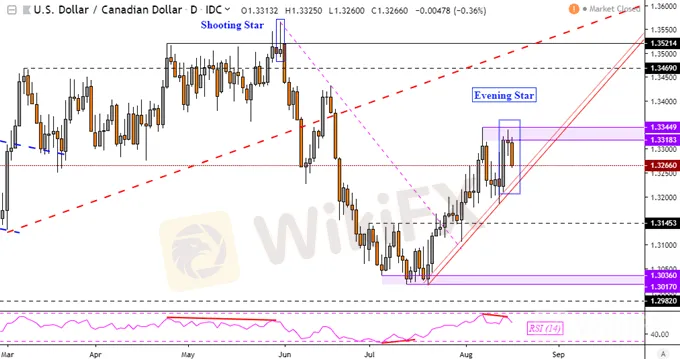简体中文
繁體中文
English
Pусский
日本語
ภาษาไทย
Tiếng Việt
Bahasa Indonesia
Español
हिन्दी
Filippiiniläinen
Français
Deutsch
Português
Türkçe
한국어
العربية
Canadian Dollar Price May Reverse Versus USD, Yen at Risk Next?
Abstract:The Canadian Dollar may be getting ready to reverse against the US Dollar after increasingly bearish USD/CAD technical signals. Ahead, the Yen may weaken as AUD and NZD gain.
Asia Pacific Market Open Talking Points
Canadian Dollar outperformed alongside the British Pound on Friday
USD/CAD could be inching closer towards a reversal of its uptrend
Asia Pacific equities may follow Wall Street higher as Yen weakens
Find out what the #1 mistake that traders make is and how you can fix it!
The sentiment-linked Canadian Dollar outperformed against its major counterparts on Friday as risk aversion cooled into the end of the week. Canadas benchmark TSX Composite rose about 0.9 percent as Wall Street continued trimming losses from Wednesday when the Dow Jones Industrial Average experienced its worst performance in a single day since 2018.
The rosy mood in financial markets, especially from North America, followed rising bets of quantitative easing out of Europe and fading concerns of a “no-deal” Brexit that lifted the British Pound as well. In the US, we saw fading intensity in the inversion of the 10-year and 3-month yield curve. The United States is Canadas largest trading partner and fading concerns of a recession in the former could boost CAD.
Canadian Dollar Technical Analysis
Taking a closer look at USD/CAD reveals increasingly bearish signals that may reverse the near-term uptrend from the middle of July. A bearish Evening Star candlestick pattern formed under resistance (1.3318 – 1.3345) as negative RSI divergence emerged. The latter shows fading upside momentum that can at times precede a reversal. This places the focus on rising channel support (parallel red lines below).
USD/CAD Daily Chart

Chart Created Using TradingView
Mondays Asia Pacific Trading Session
With that in mind, a relatively quiet economic docket to begin the new trading week during Asia Pacific hours places the focus on risk trends absent sudden updates on the trade war front. APAC equities may echo gains from Fridays Wall Street trading session, perhaps further pressuring the anti-risk Japanese Yen. Meanwhile, the pro-risk Australian and New Zealand Dollars may aim cautiously higher
FX Trading Resources
See how the S&P 500 is viewed by the trading community at the DailyFX Sentiment Page
See our free guide to learn what are the long-term forces driving Crude Oil prices
See our study on the history of trade wars to learn how it might influence financial markets!
Disclaimer:
The views in this article only represent the author's personal views, and do not constitute investment advice on this platform. This platform does not guarantee the accuracy, completeness and timeliness of the information in the article, and will not be liable for any loss caused by the use of or reliance on the information in the article.
Read more

KVB Market Analysis | 28 August: Yen Strengthens on BoJ Rate Hike Hints; USD/JPY Faces Uncertainty
The Japanese Yen rose 0.7% against the US Dollar after BoJ Governor Kazuo Ueda hinted at potential rate hikes. This coincided with a recovery in Asian markets, aided by stronger Chinese stocks. With the July FOMC minutes already pointing to a September rate cut, the US Dollar might edge higher into the weekend.

KVB Market Analysis | 27 August: AUD/USD Holds Below Seven-Month High Amid Divergent Central Bank Policies
The Australian Dollar (AUD) traded sideways against the US Dollar (USD) on Tuesday, staying just below the seven-month high of 0.6798 reached on Monday. The downside for the AUD/USD pair is expected to be limited due to differing policy outlooks between the Reserve Bank of Australia (RBA) and the US Federal Reserve. The RBA Minutes indicated that a rate cut is unlikely soon, and Governor Michele Bullock affirmed the central bank's readiness to raise rates again if necessary to combat inflation.

KVB Market Analysis | 23 August: JPY Gains Ground Against USD as BoJ Signals Possible Rate Hike
JPY strengthened against the USD, pushing USD/JPY near 145.00, driven by strong inflation data and BoJ rate hike expectations. Japan's strong Q2 GDP growth added support. However, USD gains may be limited by expectations of a Fed rate cut in September.

KVB Market Analysis | 22 August: Gold Stays Strong Above $2,500 as Fed Rate Cut Hints Loom
Gold prices remain above $2,500, near record highs, as investors await the Federal Open Market Committee minutes for confirmation of a potential Fed rate cut in September. The Fed's dovish shift, prioritizing employment over inflation, has weakened the US Dollar, boosting gold. A recent revision showing the US created 818,000 fewer jobs than initially reported also strengthens the case for a rate cut.
WikiFX Broker
Latest News
Volkswagen agrees deal to avoid Germany plant closures
Geopolitical Events: What They Are & Their Impact?
Top 10 Trading Indicators Every Forex Trader Should Know
WikiEXPO Global Expert Interview: Simone Martin—— Exploring Financial Regulation Change
TradingView Launches Liquidity Analysis Tool DEX Screener
MultiBank Group Wins Big at Traders Fair Hong Kong 2024
'Young investors make investment decisions impulsively to keep up with current trends' FCA Reveals
Why Do You Feel Scared During Trade Execution?
CySEC Settles Compliance Case with Fxview Operator Charlgate Ltd
Malaysian Influencer Detained in Taiwan Over Alleged Role in Fraud Scheme
Currency Calculator


